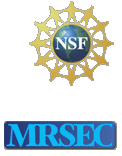Research Highlight #11:
Adsorption, Diffusion, and Self-Assembly of an Engineered Gold Binding Peptide on Au(111) by AFM
C. So, Candan Tamerler and Mehmet Sarikaya;
Materials Science & Engineering and Microbiology, University of Washington

We show here, for the first time, the morphological basis for the binding and assembly of an engineered peptide and its specific interaction with a solid surface of practical interest, i.e., Au(111). The adsorption process of the gold binding peptide is dynamic and involves multiple stages of structure evolution with corresponding surface diffusivities over time. The observed molecular structures of peptide adsorption are further explained by well-established sub-monolayer nucleation and island growth theories previously developed for metallic and semiconductor heterostructures, the basis of today’s microelectronic and magnetic thin films. Analogous to molecular recognition among biological proteins that lead to specific functions, understanding the molecular recognition of solids by engineered peptides, their self-assembly and topology, is of fundamental significance that would well form the basis of hybrid molecular technologies (e.g., molecular electronics) where immobilization of proteins, with high affinity and material selectivity, are essential components in building up protein chips, protein microarrays, and biosensors.
Contact C. So, for more details, crso@u.washington.edu.
Angew. Chem. Intl. Ed., in print (2009).



